BUMGT5970 Leadership: Reflective Report on Leadership Development
VerifiedAdded on 2023/04/04
|9
|2130
|59
Report
AI Summary
This reflective report analyzes leadership concepts learned from week 1 to 12, examining the impact of class activities on leadership capabilities. It discusses a workplace experience related to leadership, highlighting its effect on the student. The report revisits and refines a personal leadership definition based on theoretical understanding and work experiences. Key themes influencing the student, such as gender and ethics in leadership, are explored with specific examples. The report concludes that developing leadership skills is essential and can be cultivated from early stages for future application in various settings.
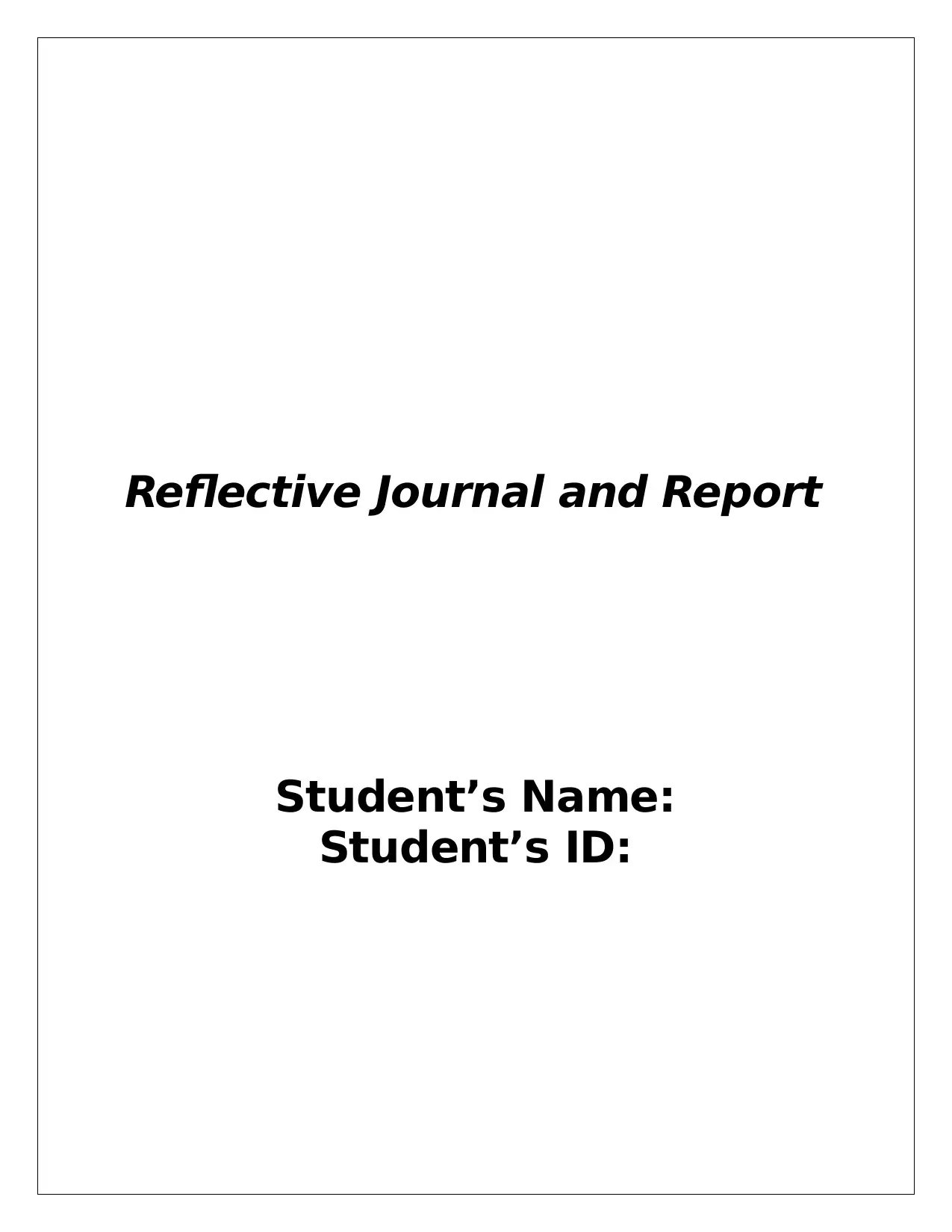
Reflective Journal and Report
Student’s Name:
Student’s ID:
Student’s Name:
Student’s ID:
Paraphrase This Document
Need a fresh take? Get an instant paraphrase of this document with our AI Paraphraser
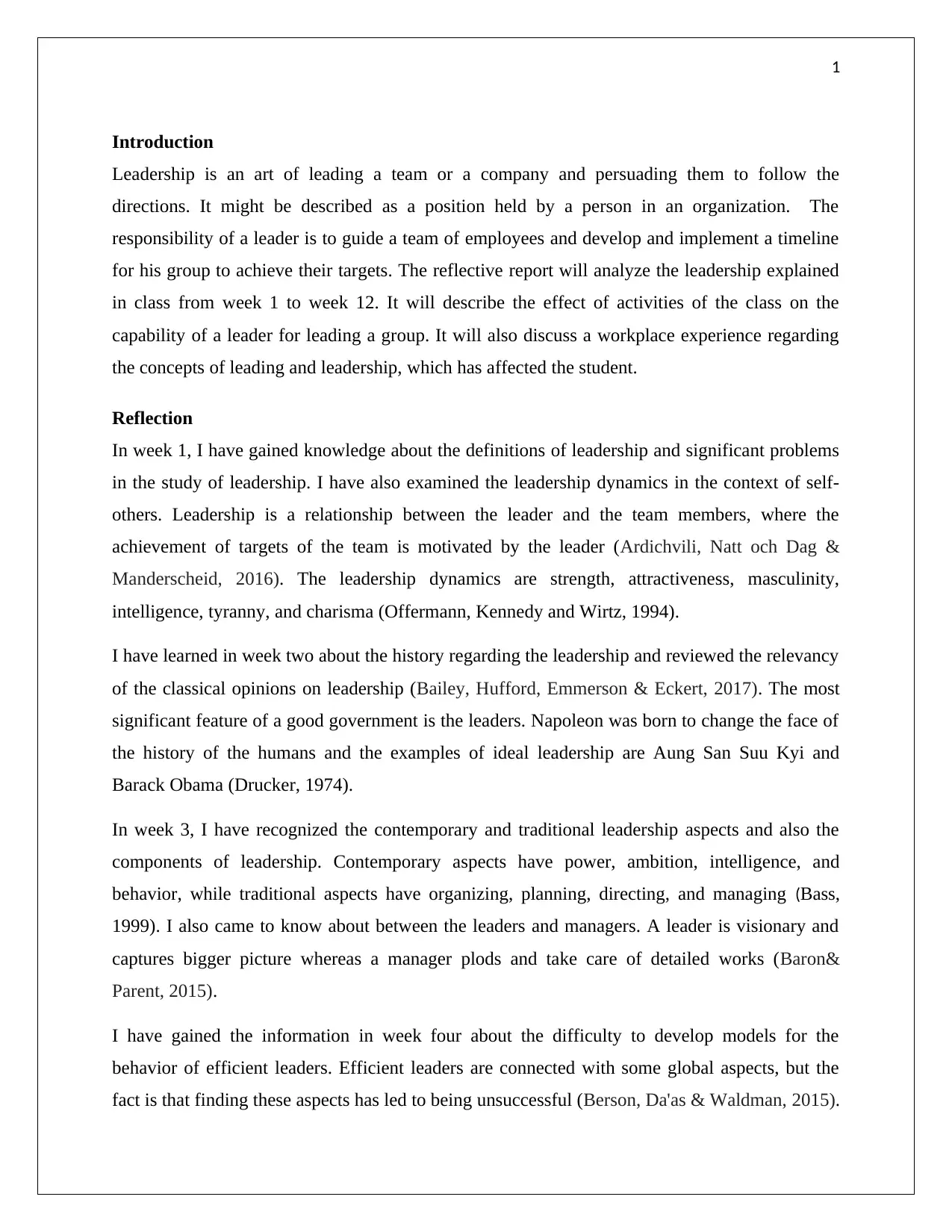
1
Introduction
Leadership is an art of leading a team or a company and persuading them to follow the
directions. It might be described as a position held by a person in an organization. The
responsibility of a leader is to guide a team of employees and develop and implement a timeline
for his group to achieve their targets. The reflective report will analyze the leadership explained
in class from week 1 to week 12. It will describe the effect of activities of the class on the
capability of a leader for leading a group. It will also discuss a workplace experience regarding
the concepts of leading and leadership, which has affected the student.
Reflection
In week 1, I have gained knowledge about the definitions of leadership and significant problems
in the study of leadership. I have also examined the leadership dynamics in the context of self-
others. Leadership is a relationship between the leader and the team members, where the
achievement of targets of the team is motivated by the leader (Ardichvili, Natt och Dag &
Manderscheid, 2016). The leadership dynamics are strength, attractiveness, masculinity,
intelligence, tyranny, and charisma (Offermann, Kennedy and Wirtz, 1994).
I have learned in week two about the history regarding the leadership and reviewed the relevancy
of the classical opinions on leadership (Bailey, Hufford, Emmerson & Eckert, 2017). The most
significant feature of a good government is the leaders. Napoleon was born to change the face of
the history of the humans and the examples of ideal leadership are Aung San Suu Kyi and
Barack Obama (Drucker, 1974).
In week 3, I have recognized the contemporary and traditional leadership aspects and also the
components of leadership. Contemporary aspects have power, ambition, intelligence, and
behavior, while traditional aspects have organizing, planning, directing, and managing (Bass,
1999). I also came to know about between the leaders and managers. A leader is visionary and
captures bigger picture whereas a manager plods and take care of detailed works (Baron&
Parent, 2015).
I have gained the information in week four about the difficulty to develop models for the
behavior of efficient leaders. Efficient leaders are connected with some global aspects, but the
fact is that finding these aspects has led to being unsuccessful (Berson, Da'as & Waldman, 2015).
Introduction
Leadership is an art of leading a team or a company and persuading them to follow the
directions. It might be described as a position held by a person in an organization. The
responsibility of a leader is to guide a team of employees and develop and implement a timeline
for his group to achieve their targets. The reflective report will analyze the leadership explained
in class from week 1 to week 12. It will describe the effect of activities of the class on the
capability of a leader for leading a group. It will also discuss a workplace experience regarding
the concepts of leading and leadership, which has affected the student.
Reflection
In week 1, I have gained knowledge about the definitions of leadership and significant problems
in the study of leadership. I have also examined the leadership dynamics in the context of self-
others. Leadership is a relationship between the leader and the team members, where the
achievement of targets of the team is motivated by the leader (Ardichvili, Natt och Dag &
Manderscheid, 2016). The leadership dynamics are strength, attractiveness, masculinity,
intelligence, tyranny, and charisma (Offermann, Kennedy and Wirtz, 1994).
I have learned in week two about the history regarding the leadership and reviewed the relevancy
of the classical opinions on leadership (Bailey, Hufford, Emmerson & Eckert, 2017). The most
significant feature of a good government is the leaders. Napoleon was born to change the face of
the history of the humans and the examples of ideal leadership are Aung San Suu Kyi and
Barack Obama (Drucker, 1974).
In week 3, I have recognized the contemporary and traditional leadership aspects and also the
components of leadership. Contemporary aspects have power, ambition, intelligence, and
behavior, while traditional aspects have organizing, planning, directing, and managing (Bass,
1999). I also came to know about between the leaders and managers. A leader is visionary and
captures bigger picture whereas a manager plods and take care of detailed works (Baron&
Parent, 2015).
I have gained the information in week four about the difficulty to develop models for the
behavior of efficient leaders. Efficient leaders are connected with some global aspects, but the
fact is that finding these aspects has led to being unsuccessful (Berson, Da'as & Waldman, 2015).
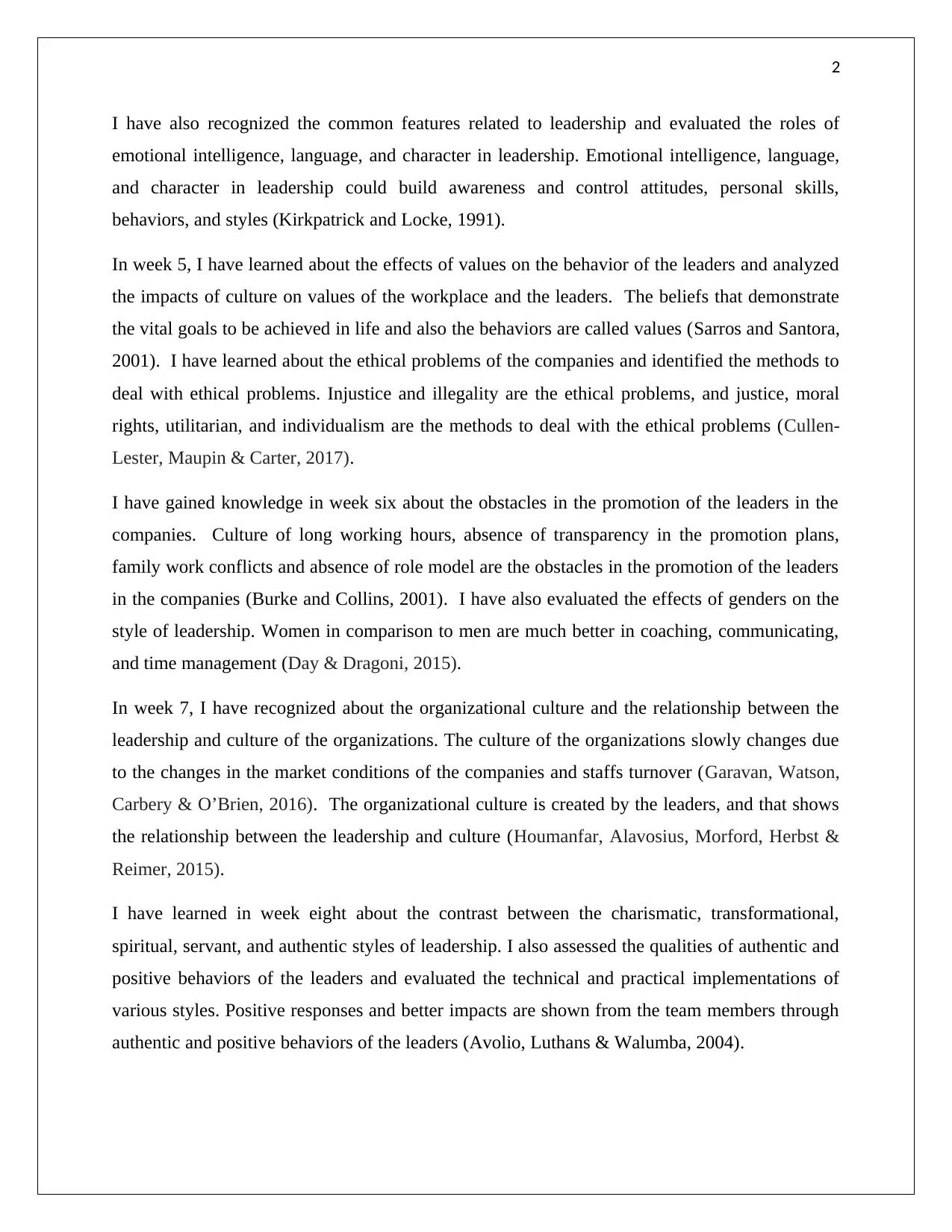
2
I have also recognized the common features related to leadership and evaluated the roles of
emotional intelligence, language, and character in leadership. Emotional intelligence, language,
and character in leadership could build awareness and control attitudes, personal skills,
behaviors, and styles (Kirkpatrick and Locke, 1991).
In week 5, I have learned about the effects of values on the behavior of the leaders and analyzed
the impacts of culture on values of the workplace and the leaders. The beliefs that demonstrate
the vital goals to be achieved in life and also the behaviors are called values (Sarros and Santora,
2001). I have learned about the ethical problems of the companies and identified the methods to
deal with ethical problems. Injustice and illegality are the ethical problems, and justice, moral
rights, utilitarian, and individualism are the methods to deal with the ethical problems (Cullen-
Lester, Maupin & Carter, 2017).
I have gained knowledge in week six about the obstacles in the promotion of the leaders in the
companies. Culture of long working hours, absence of transparency in the promotion plans,
family work conflicts and absence of role model are the obstacles in the promotion of the leaders
in the companies (Burke and Collins, 2001). I have also evaluated the effects of genders on the
style of leadership. Women in comparison to men are much better in coaching, communicating,
and time management (Day & Dragoni, 2015).
In week 7, I have recognized about the organizational culture and the relationship between the
leadership and culture of the organizations. The culture of the organizations slowly changes due
to the changes in the market conditions of the companies and staffs turnover (Garavan, Watson,
Carbery & O’Brien, 2016). The organizational culture is created by the leaders, and that shows
the relationship between the leadership and culture (Houmanfar, Alavosius, Morford, Herbst &
Reimer, 2015).
I have learned in week eight about the contrast between the charismatic, transformational,
spiritual, servant, and authentic styles of leadership. I also assessed the qualities of authentic and
positive behaviors of the leaders and evaluated the technical and practical implementations of
various styles. Positive responses and better impacts are shown from the team members through
authentic and positive behaviors of the leaders (Avolio, Luthans & Walumba, 2004).
I have also recognized the common features related to leadership and evaluated the roles of
emotional intelligence, language, and character in leadership. Emotional intelligence, language,
and character in leadership could build awareness and control attitudes, personal skills,
behaviors, and styles (Kirkpatrick and Locke, 1991).
In week 5, I have learned about the effects of values on the behavior of the leaders and analyzed
the impacts of culture on values of the workplace and the leaders. The beliefs that demonstrate
the vital goals to be achieved in life and also the behaviors are called values (Sarros and Santora,
2001). I have learned about the ethical problems of the companies and identified the methods to
deal with ethical problems. Injustice and illegality are the ethical problems, and justice, moral
rights, utilitarian, and individualism are the methods to deal with the ethical problems (Cullen-
Lester, Maupin & Carter, 2017).
I have gained knowledge in week six about the obstacles in the promotion of the leaders in the
companies. Culture of long working hours, absence of transparency in the promotion plans,
family work conflicts and absence of role model are the obstacles in the promotion of the leaders
in the companies (Burke and Collins, 2001). I have also evaluated the effects of genders on the
style of leadership. Women in comparison to men are much better in coaching, communicating,
and time management (Day & Dragoni, 2015).
In week 7, I have recognized about the organizational culture and the relationship between the
leadership and culture of the organizations. The culture of the organizations slowly changes due
to the changes in the market conditions of the companies and staffs turnover (Garavan, Watson,
Carbery & O’Brien, 2016). The organizational culture is created by the leaders, and that shows
the relationship between the leadership and culture (Houmanfar, Alavosius, Morford, Herbst &
Reimer, 2015).
I have learned in week eight about the contrast between the charismatic, transformational,
spiritual, servant, and authentic styles of leadership. I also assessed the qualities of authentic and
positive behaviors of the leaders and evaluated the technical and practical implementations of
various styles. Positive responses and better impacts are shown from the team members through
authentic and positive behaviors of the leaders (Avolio, Luthans & Walumba, 2004).
⊘ This is a preview!⊘
Do you want full access?
Subscribe today to unlock all pages.

Trusted by 1+ million students worldwide
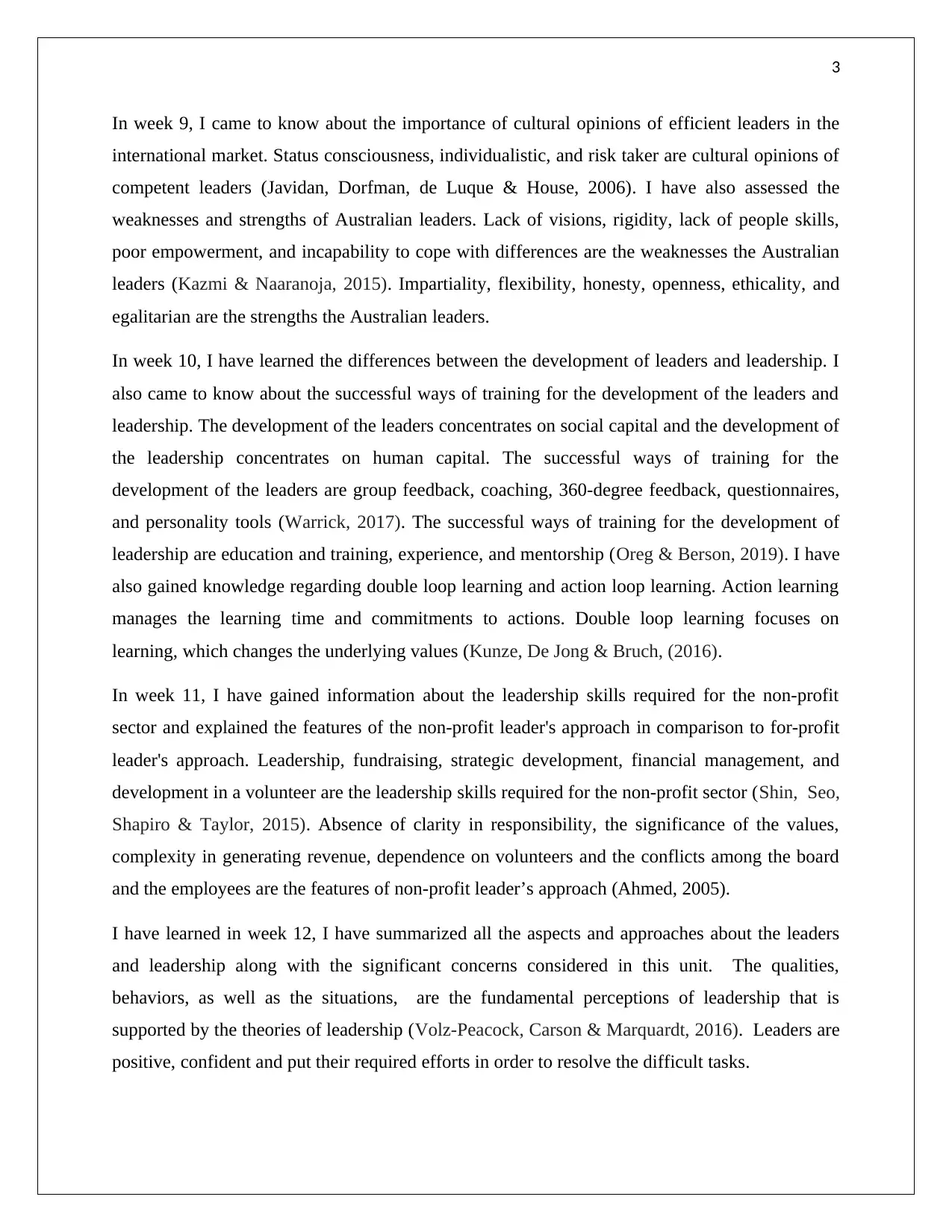
3
In week 9, I came to know about the importance of cultural opinions of efficient leaders in the
international market. Status consciousness, individualistic, and risk taker are cultural opinions of
competent leaders (Javidan, Dorfman, de Luque & House, 2006). I have also assessed the
weaknesses and strengths of Australian leaders. Lack of visions, rigidity, lack of people skills,
poor empowerment, and incapability to cope with differences are the weaknesses the Australian
leaders (Kazmi & Naaranoja, 2015). Impartiality, flexibility, honesty, openness, ethicality, and
egalitarian are the strengths the Australian leaders.
In week 10, I have learned the differences between the development of leaders and leadership. I
also came to know about the successful ways of training for the development of the leaders and
leadership. The development of the leaders concentrates on social capital and the development of
the leadership concentrates on human capital. The successful ways of training for the
development of the leaders are group feedback, coaching, 360-degree feedback, questionnaires,
and personality tools (Warrick, 2017). The successful ways of training for the development of
leadership are education and training, experience, and mentorship (Oreg & Berson, 2019). I have
also gained knowledge regarding double loop learning and action loop learning. Action learning
manages the learning time and commitments to actions. Double loop learning focuses on
learning, which changes the underlying values (Kunze, De Jong & Bruch, (2016).
In week 11, I have gained information about the leadership skills required for the non-profit
sector and explained the features of the non-profit leader's approach in comparison to for-profit
leader's approach. Leadership, fundraising, strategic development, financial management, and
development in a volunteer are the leadership skills required for the non-profit sector (Shin, Seo,
Shapiro & Taylor, 2015). Absence of clarity in responsibility, the significance of the values,
complexity in generating revenue, dependence on volunteers and the conflicts among the board
and the employees are the features of non-profit leader’s approach (Ahmed, 2005).
I have learned in week 12, I have summarized all the aspects and approaches about the leaders
and leadership along with the significant concerns considered in this unit. The qualities,
behaviors, as well as the situations, are the fundamental perceptions of leadership that is
supported by the theories of leadership (Volz-Peacock, Carson & Marquardt, 2016). Leaders are
positive, confident and put their required efforts in order to resolve the difficult tasks.
In week 9, I came to know about the importance of cultural opinions of efficient leaders in the
international market. Status consciousness, individualistic, and risk taker are cultural opinions of
competent leaders (Javidan, Dorfman, de Luque & House, 2006). I have also assessed the
weaknesses and strengths of Australian leaders. Lack of visions, rigidity, lack of people skills,
poor empowerment, and incapability to cope with differences are the weaknesses the Australian
leaders (Kazmi & Naaranoja, 2015). Impartiality, flexibility, honesty, openness, ethicality, and
egalitarian are the strengths the Australian leaders.
In week 10, I have learned the differences between the development of leaders and leadership. I
also came to know about the successful ways of training for the development of the leaders and
leadership. The development of the leaders concentrates on social capital and the development of
the leadership concentrates on human capital. The successful ways of training for the
development of the leaders are group feedback, coaching, 360-degree feedback, questionnaires,
and personality tools (Warrick, 2017). The successful ways of training for the development of
leadership are education and training, experience, and mentorship (Oreg & Berson, 2019). I have
also gained knowledge regarding double loop learning and action loop learning. Action learning
manages the learning time and commitments to actions. Double loop learning focuses on
learning, which changes the underlying values (Kunze, De Jong & Bruch, (2016).
In week 11, I have gained information about the leadership skills required for the non-profit
sector and explained the features of the non-profit leader's approach in comparison to for-profit
leader's approach. Leadership, fundraising, strategic development, financial management, and
development in a volunteer are the leadership skills required for the non-profit sector (Shin, Seo,
Shapiro & Taylor, 2015). Absence of clarity in responsibility, the significance of the values,
complexity in generating revenue, dependence on volunteers and the conflicts among the board
and the employees are the features of non-profit leader’s approach (Ahmed, 2005).
I have learned in week 12, I have summarized all the aspects and approaches about the leaders
and leadership along with the significant concerns considered in this unit. The qualities,
behaviors, as well as the situations, are the fundamental perceptions of leadership that is
supported by the theories of leadership (Volz-Peacock, Carson & Marquardt, 2016). Leaders are
positive, confident and put their required efforts in order to resolve the difficult tasks.
Paraphrase This Document
Need a fresh take? Get an instant paraphrase of this document with our AI Paraphraser
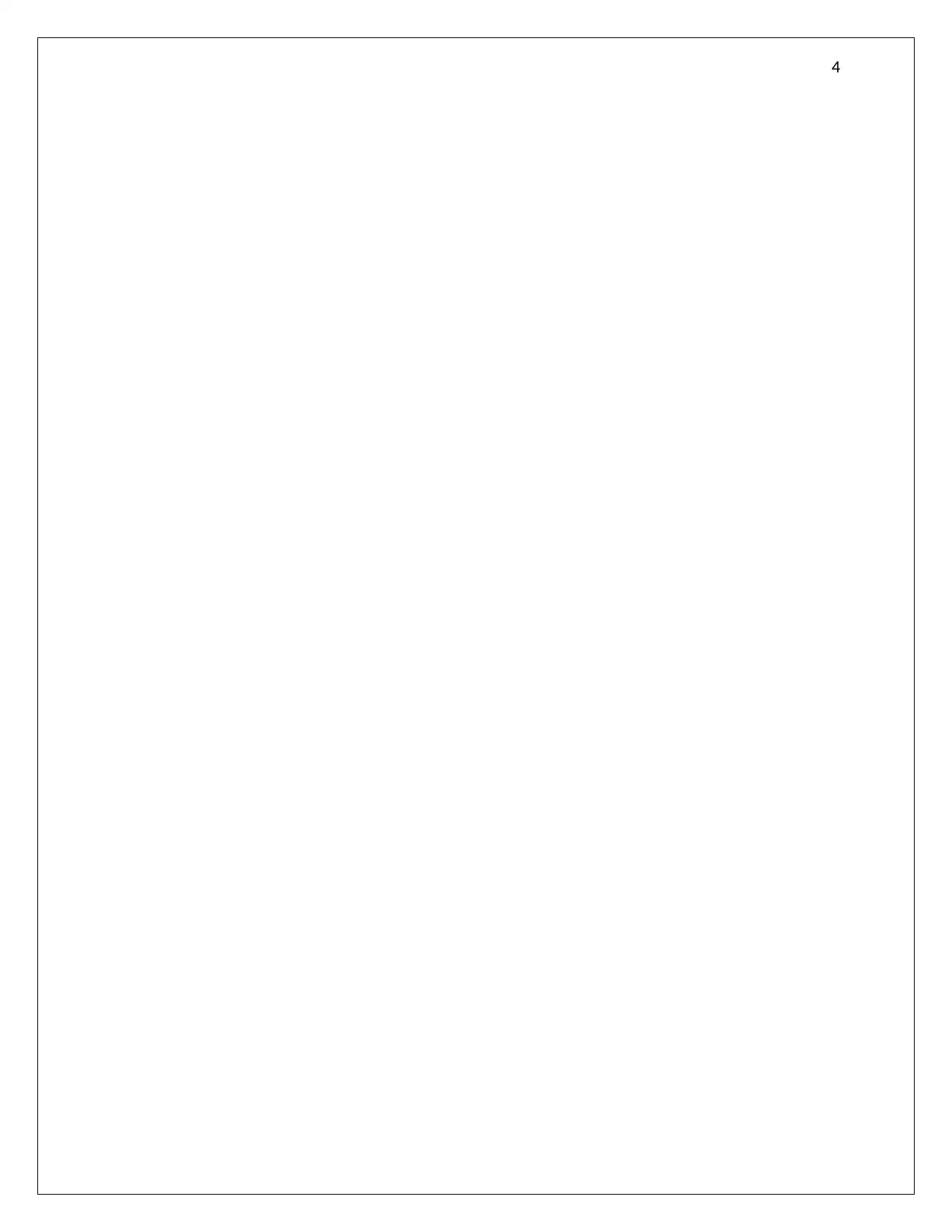
4
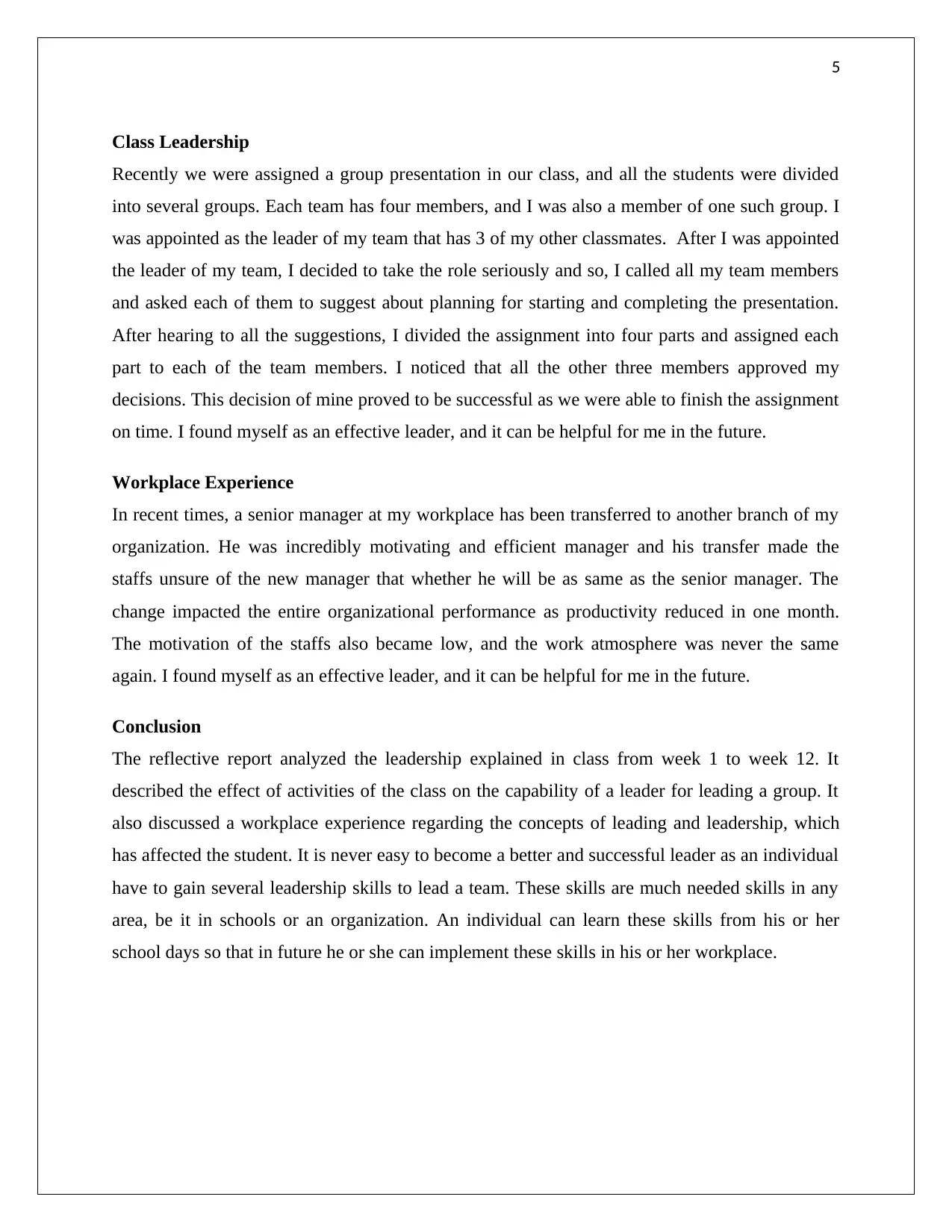
5
Class Leadership
Recently we were assigned a group presentation in our class, and all the students were divided
into several groups. Each team has four members, and I was also a member of one such group. I
was appointed as the leader of my team that has 3 of my other classmates. After I was appointed
the leader of my team, I decided to take the role seriously and so, I called all my team members
and asked each of them to suggest about planning for starting and completing the presentation.
After hearing to all the suggestions, I divided the assignment into four parts and assigned each
part to each of the team members. I noticed that all the other three members approved my
decisions. This decision of mine proved to be successful as we were able to finish the assignment
on time. I found myself as an effective leader, and it can be helpful for me in the future.
Workplace Experience
In recent times, a senior manager at my workplace has been transferred to another branch of my
organization. He was incredibly motivating and efficient manager and his transfer made the
staffs unsure of the new manager that whether he will be as same as the senior manager. The
change impacted the entire organizational performance as productivity reduced in one month.
The motivation of the staffs also became low, and the work atmosphere was never the same
again. I found myself as an effective leader, and it can be helpful for me in the future.
Conclusion
The reflective report analyzed the leadership explained in class from week 1 to week 12. It
described the effect of activities of the class on the capability of a leader for leading a group. It
also discussed a workplace experience regarding the concepts of leading and leadership, which
has affected the student. It is never easy to become a better and successful leader as an individual
have to gain several leadership skills to lead a team. These skills are much needed skills in any
area, be it in schools or an organization. An individual can learn these skills from his or her
school days so that in future he or she can implement these skills in his or her workplace.
Class Leadership
Recently we were assigned a group presentation in our class, and all the students were divided
into several groups. Each team has four members, and I was also a member of one such group. I
was appointed as the leader of my team that has 3 of my other classmates. After I was appointed
the leader of my team, I decided to take the role seriously and so, I called all my team members
and asked each of them to suggest about planning for starting and completing the presentation.
After hearing to all the suggestions, I divided the assignment into four parts and assigned each
part to each of the team members. I noticed that all the other three members approved my
decisions. This decision of mine proved to be successful as we were able to finish the assignment
on time. I found myself as an effective leader, and it can be helpful for me in the future.
Workplace Experience
In recent times, a senior manager at my workplace has been transferred to another branch of my
organization. He was incredibly motivating and efficient manager and his transfer made the
staffs unsure of the new manager that whether he will be as same as the senior manager. The
change impacted the entire organizational performance as productivity reduced in one month.
The motivation of the staffs also became low, and the work atmosphere was never the same
again. I found myself as an effective leader, and it can be helpful for me in the future.
Conclusion
The reflective report analyzed the leadership explained in class from week 1 to week 12. It
described the effect of activities of the class on the capability of a leader for leading a group. It
also discussed a workplace experience regarding the concepts of leading and leadership, which
has affected the student. It is never easy to become a better and successful leader as an individual
have to gain several leadership skills to lead a team. These skills are much needed skills in any
area, be it in schools or an organization. An individual can learn these skills from his or her
school days so that in future he or she can implement these skills in his or her workplace.
⊘ This is a preview!⊘
Do you want full access?
Subscribe today to unlock all pages.

Trusted by 1+ million students worldwide
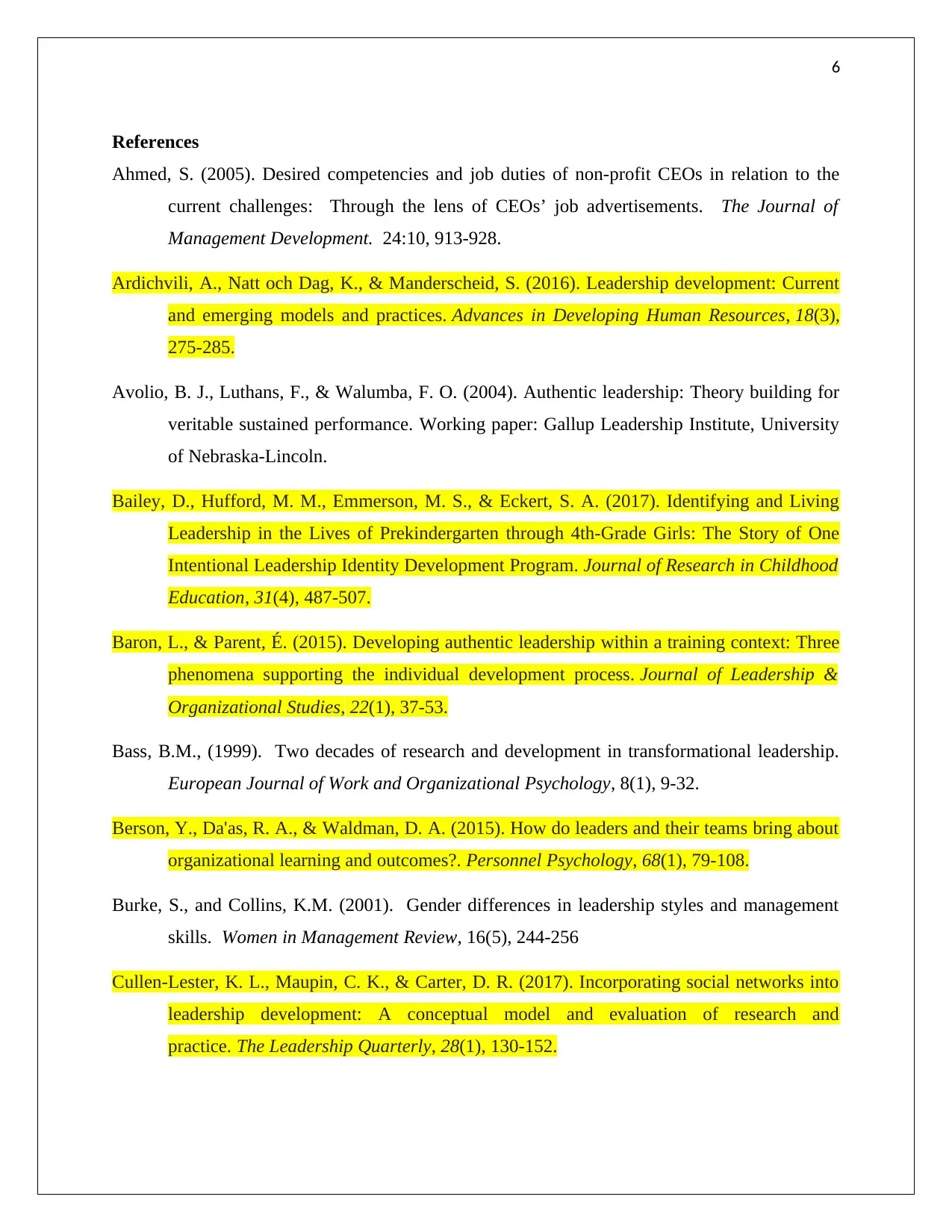
6
References
Ahmed, S. (2005). Desired competencies and job duties of non-profit CEOs in relation to the
current challenges: Through the lens of CEOs’ job advertisements. The Journal of
Management Development. 24:10, 913-928.
Ardichvili, A., Natt och Dag, K., & Manderscheid, S. (2016). Leadership development: Current
and emerging models and practices. Advances in Developing Human Resources, 18(3),
275-285.
Avolio, B. J., Luthans, F., & Walumba, F. O. (2004). Authentic leadership: Theory building for
veritable sustained performance. Working paper: Gallup Leadership Institute, University
of Nebraska-Lincoln.
Bailey, D., Hufford, M. M., Emmerson, M. S., & Eckert, S. A. (2017). Identifying and Living
Leadership in the Lives of Prekindergarten through 4th-Grade Girls: The Story of One
Intentional Leadership Identity Development Program. Journal of Research in Childhood
Education, 31(4), 487-507.
Baron, L., & Parent, É. (2015). Developing authentic leadership within a training context: Three
phenomena supporting the individual development process. Journal of Leadership &
Organizational Studies, 22(1), 37-53.
Bass, B.M., (1999). Two decades of research and development in transformational leadership.
European Journal of Work and Organizational Psychology, 8(1), 9-32.
Berson, Y., Da'as, R. A., & Waldman, D. A. (2015). How do leaders and their teams bring about
organizational learning and outcomes?. Personnel Psychology, 68(1), 79-108.
Burke, S., and Collins, K.M. (2001). Gender differences in leadership styles and management
skills. Women in Management Review, 16(5), 244-256
Cullen-Lester, K. L., Maupin, C. K., & Carter, D. R. (2017). Incorporating social networks into
leadership development: A conceptual model and evaluation of research and
practice. The Leadership Quarterly, 28(1), 130-152.
References
Ahmed, S. (2005). Desired competencies and job duties of non-profit CEOs in relation to the
current challenges: Through the lens of CEOs’ job advertisements. The Journal of
Management Development. 24:10, 913-928.
Ardichvili, A., Natt och Dag, K., & Manderscheid, S. (2016). Leadership development: Current
and emerging models and practices. Advances in Developing Human Resources, 18(3),
275-285.
Avolio, B. J., Luthans, F., & Walumba, F. O. (2004). Authentic leadership: Theory building for
veritable sustained performance. Working paper: Gallup Leadership Institute, University
of Nebraska-Lincoln.
Bailey, D., Hufford, M. M., Emmerson, M. S., & Eckert, S. A. (2017). Identifying and Living
Leadership in the Lives of Prekindergarten through 4th-Grade Girls: The Story of One
Intentional Leadership Identity Development Program. Journal of Research in Childhood
Education, 31(4), 487-507.
Baron, L., & Parent, É. (2015). Developing authentic leadership within a training context: Three
phenomena supporting the individual development process. Journal of Leadership &
Organizational Studies, 22(1), 37-53.
Bass, B.M., (1999). Two decades of research and development in transformational leadership.
European Journal of Work and Organizational Psychology, 8(1), 9-32.
Berson, Y., Da'as, R. A., & Waldman, D. A. (2015). How do leaders and their teams bring about
organizational learning and outcomes?. Personnel Psychology, 68(1), 79-108.
Burke, S., and Collins, K.M. (2001). Gender differences in leadership styles and management
skills. Women in Management Review, 16(5), 244-256
Cullen-Lester, K. L., Maupin, C. K., & Carter, D. R. (2017). Incorporating social networks into
leadership development: A conceptual model and evaluation of research and
practice. The Leadership Quarterly, 28(1), 130-152.
Paraphrase This Document
Need a fresh take? Get an instant paraphrase of this document with our AI Paraphraser
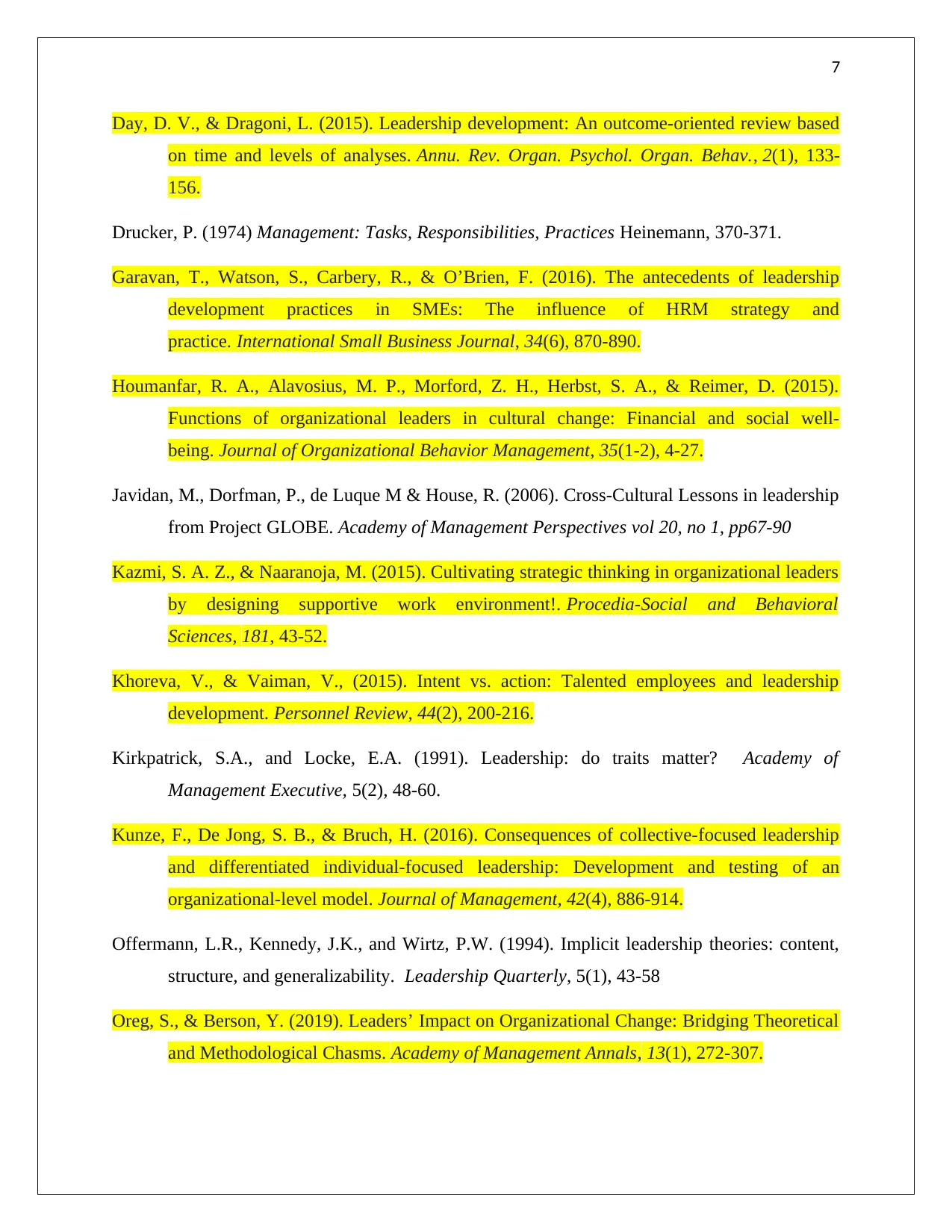
7
Day, D. V., & Dragoni, L. (2015). Leadership development: An outcome-oriented review based
on time and levels of analyses. Annu. Rev. Organ. Psychol. Organ. Behav., 2(1), 133-
156.
Drucker, P. (1974) Management: Tasks, Responsibilities, Practices Heinemann, 370-371.
Garavan, T., Watson, S., Carbery, R., & O’Brien, F. (2016). The antecedents of leadership
development practices in SMEs: The influence of HRM strategy and
practice. International Small Business Journal, 34(6), 870-890.
Houmanfar, R. A., Alavosius, M. P., Morford, Z. H., Herbst, S. A., & Reimer, D. (2015).
Functions of organizational leaders in cultural change: Financial and social well-
being. Journal of Organizational Behavior Management, 35(1-2), 4-27.
Javidan, M., Dorfman, P., de Luque M & House, R. (2006). Cross-Cultural Lessons in leadership
from Project GLOBE. Academy of Management Perspectives vol 20, no 1, pp67-90
Kazmi, S. A. Z., & Naaranoja, M. (2015). Cultivating strategic thinking in organizational leaders
by designing supportive work environment!. Procedia-Social and Behavioral
Sciences, 181, 43-52.
Khoreva, V., & Vaiman, V., (2015). Intent vs. action: Talented employees and leadership
development. Personnel Review, 44(2), 200-216.
Kirkpatrick, S.A., and Locke, E.A. (1991). Leadership: do traits matter? Academy of
Management Executive, 5(2), 48-60.
Kunze, F., De Jong, S. B., & Bruch, H. (2016). Consequences of collective-focused leadership
and differentiated individual-focused leadership: Development and testing of an
organizational-level model. Journal of Management, 42(4), 886-914.
Offermann, L.R., Kennedy, J.K., and Wirtz, P.W. (1994). Implicit leadership theories: content,
structure, and generalizability. Leadership Quarterly, 5(1), 43-58
Oreg, S., & Berson, Y. (2019). Leaders’ Impact on Organizational Change: Bridging Theoretical
and Methodological Chasms. Academy of Management Annals, 13(1), 272-307.
Day, D. V., & Dragoni, L. (2015). Leadership development: An outcome-oriented review based
on time and levels of analyses. Annu. Rev. Organ. Psychol. Organ. Behav., 2(1), 133-
156.
Drucker, P. (1974) Management: Tasks, Responsibilities, Practices Heinemann, 370-371.
Garavan, T., Watson, S., Carbery, R., & O’Brien, F. (2016). The antecedents of leadership
development practices in SMEs: The influence of HRM strategy and
practice. International Small Business Journal, 34(6), 870-890.
Houmanfar, R. A., Alavosius, M. P., Morford, Z. H., Herbst, S. A., & Reimer, D. (2015).
Functions of organizational leaders in cultural change: Financial and social well-
being. Journal of Organizational Behavior Management, 35(1-2), 4-27.
Javidan, M., Dorfman, P., de Luque M & House, R. (2006). Cross-Cultural Lessons in leadership
from Project GLOBE. Academy of Management Perspectives vol 20, no 1, pp67-90
Kazmi, S. A. Z., & Naaranoja, M. (2015). Cultivating strategic thinking in organizational leaders
by designing supportive work environment!. Procedia-Social and Behavioral
Sciences, 181, 43-52.
Khoreva, V., & Vaiman, V., (2015). Intent vs. action: Talented employees and leadership
development. Personnel Review, 44(2), 200-216.
Kirkpatrick, S.A., and Locke, E.A. (1991). Leadership: do traits matter? Academy of
Management Executive, 5(2), 48-60.
Kunze, F., De Jong, S. B., & Bruch, H. (2016). Consequences of collective-focused leadership
and differentiated individual-focused leadership: Development and testing of an
organizational-level model. Journal of Management, 42(4), 886-914.
Offermann, L.R., Kennedy, J.K., and Wirtz, P.W. (1994). Implicit leadership theories: content,
structure, and generalizability. Leadership Quarterly, 5(1), 43-58
Oreg, S., & Berson, Y. (2019). Leaders’ Impact on Organizational Change: Bridging Theoretical
and Methodological Chasms. Academy of Management Annals, 13(1), 272-307.
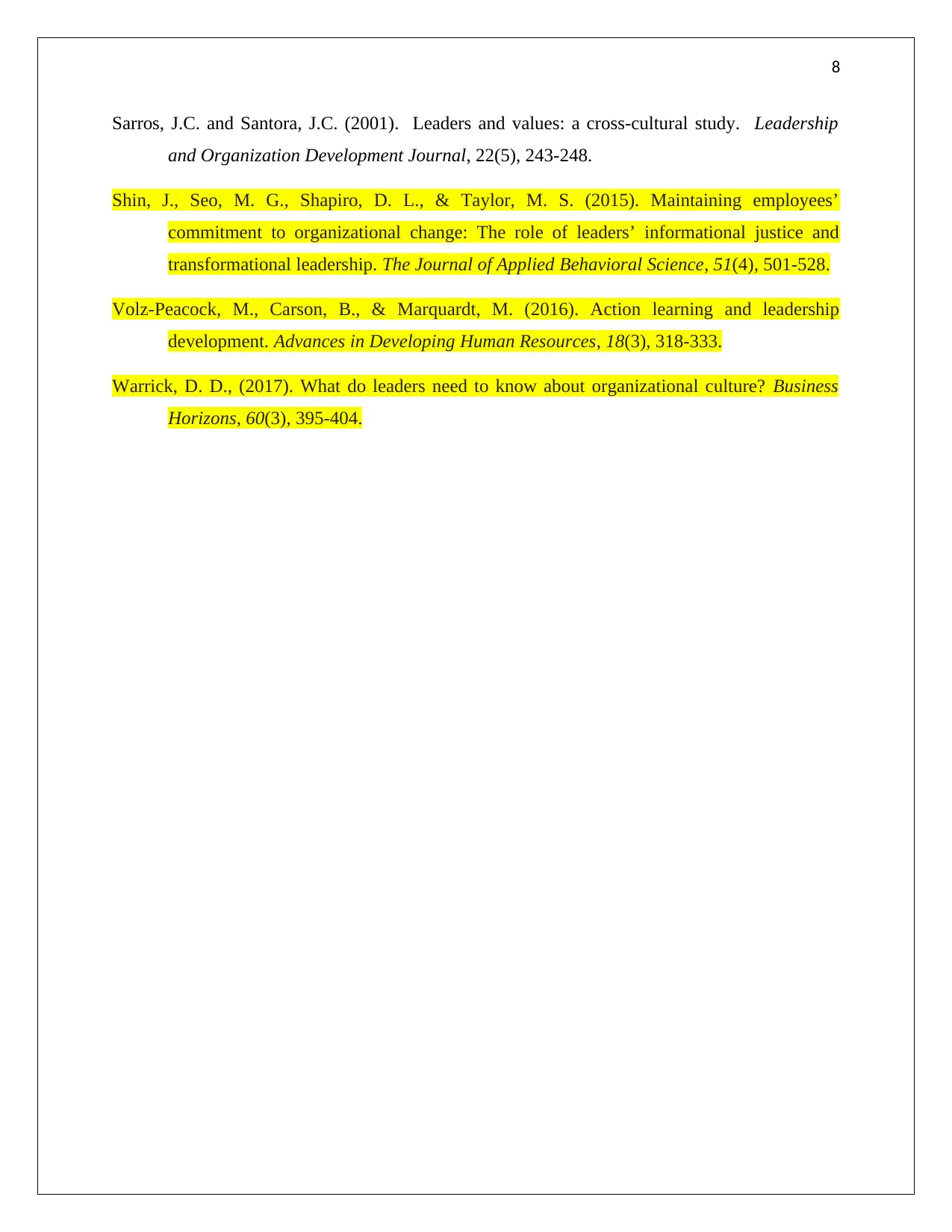
8
Sarros, J.C. and Santora, J.C. (2001). Leaders and values: a cross-cultural study. Leadership
and Organization Development Journal, 22(5), 243-248.
Shin, J., Seo, M. G., Shapiro, D. L., & Taylor, M. S. (2015). Maintaining employees’
commitment to organizational change: The role of leaders’ informational justice and
transformational leadership. The Journal of Applied Behavioral Science, 51(4), 501-528.
Volz-Peacock, M., Carson, B., & Marquardt, M. (2016). Action learning and leadership
development. Advances in Developing Human Resources, 18(3), 318-333.
Warrick, D. D., (2017). What do leaders need to know about organizational culture? Business
Horizons, 60(3), 395-404.
Sarros, J.C. and Santora, J.C. (2001). Leaders and values: a cross-cultural study. Leadership
and Organization Development Journal, 22(5), 243-248.
Shin, J., Seo, M. G., Shapiro, D. L., & Taylor, M. S. (2015). Maintaining employees’
commitment to organizational change: The role of leaders’ informational justice and
transformational leadership. The Journal of Applied Behavioral Science, 51(4), 501-528.
Volz-Peacock, M., Carson, B., & Marquardt, M. (2016). Action learning and leadership
development. Advances in Developing Human Resources, 18(3), 318-333.
Warrick, D. D., (2017). What do leaders need to know about organizational culture? Business
Horizons, 60(3), 395-404.
⊘ This is a preview!⊘
Do you want full access?
Subscribe today to unlock all pages.

Trusted by 1+ million students worldwide
1 out of 9
Related Documents
Your All-in-One AI-Powered Toolkit for Academic Success.
+13062052269
info@desklib.com
Available 24*7 on WhatsApp / Email
![[object Object]](/_next/static/media/star-bottom.7253800d.svg)
Unlock your academic potential
Copyright © 2020–2025 A2Z Services. All Rights Reserved. Developed and managed by ZUCOL.





![Leadership Development: Personal Reflection Report, [University Name]](/_next/image/?url=https%3A%2F%2Fdesklib.com%2Fmedia%2Fimages%2Fgf%2F0b30c9f93676433e8e7ecf589570567f.jpg&w=256&q=75)